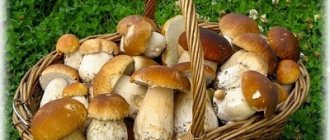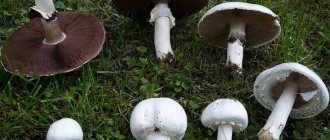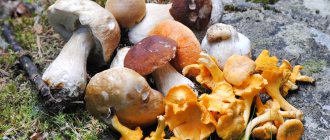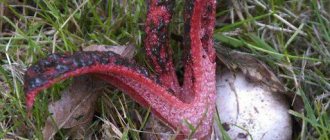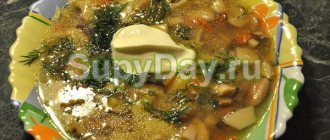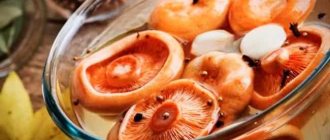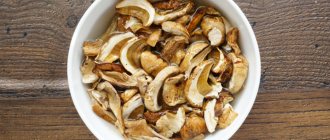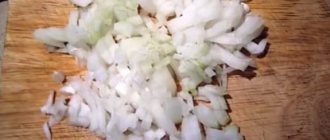Imagine: you were walking through the forest and suddenly you discovered your toes sticking out from under a fallen tree trunk. The rest of the body is not nearby: either it rotted, or an unknown maniac hid only the leg here. However, if you are not the shy type, you will find that it is just a mushroom. A stunning representative of the Dead Man's Fingers species - you can't think of a better name for it.
There's a mushroom fan group on Facebook called Mushroomcore. The community is dedicated to the most unusual representatives of this kingdom of living nature and boundless love for them. In June, one of its members, Regan Daniels from North Carolina, posted photos of an object that looked like the fingers of a corpse sticking out from under a tree:
“I found this mushroom in western North Carolina, in the USA, in a park where I often walk,” says Regan, adding that the place is wonderful, but too crowded, “it’s nice to walk here, the French Broad River flows nearby, so there are many picturesque species."
Some of the band members thought it was fake and Regan was just trying to prank them. Even Daniels herself admitted that at first she mistook the find for some kind of Halloween decorations that somehow ended up in the forest. However, this is a living creature: here is a mushroom that is literally called "Dead Man's Fingers", and it has probably scared more than one generation of Europeans and Americans. Suffice it to say that in the old days the cemetery could simply be abandoned after discovering this “devilish spawn” in it.
Its scientific name is Xylaria polymorpha, it is native to Europe and North America and is characterized by its slow growth. So these “fingers” can be found in the forests throughout the summer and autumn. True, at first they look like pale, ghostly pods, and in the end they look like the feces of some animal. All in all, catching Dead Man's Fingers at their creepiest is not so easy.
This fungus feeds on rotten wood and can be found on stumps or fallen trunks. Sometimes it grows straight out of the ground, but this only means that a rotting piece of wood is hiding under a thin layer of soil. Dead Man's Fingers are also inedible (although not poisonous), but you probably wouldn't try something so reminiscent of zombies anyway. However, there is information about what they taste like: young ones are completely insipid, and old ones taste rotten. There are even people who claim that when boiled, these mushrooms taste of citrus, but this is unverified information.
The old Dead Man's Fingers.
Even mature Xylaria polymorpha do not always look like the fingers of a dead man, but they seem to be trying to do everything to achieve this: the fruiting bodies often grow in a “pack” of 4-6 pieces, have light areas resembling fingernails, and are often curled. In general, this is truly a ready-made Halloween decoration. Apparently, this is why they are not so often used in folk medicine, although they contain diuretics, that is, a diuretic.
By the way, in addition to “dead man’s fingers,” there are other mushrooms that remind us of parts of human bodies that somehow ended up in the forest:
Dead man's fingers mushroom: where does it grow?
In most cases, dead man's fingers grow on logs or decaying stumps of deciduous trees.
Most often they are located closer to the roots, but sometimes they are actually from the ground, although in fact we are talking about areas of soil around the trunk that are richly fertilized with dead wood. The mushroom usually grows in a group, but can also grow alone. Promotes wood rotting. It is found in almost every corner of the world, preferring distribution zones:
- elms;
- beech trees;
- oak trees
Sometimes they grow on coniferous trees. Prefers dead trees, but can sometimes grow on living ones, provided they are damaged or weakened. On the territory of Russia they are found throughout the forest zone, from May to the end of November.
Prevalence of the fungus
Devil's fingers are native to Australia and New Zealand, and a little later it appeared in Asia, Africa, America, St. Helena and Mauritius. In European countries this mushroom is treated as an alien, but no one knows how this mushroom appeared. There is an opinion that when the textile industry was brought into France in 1915, the mushroom was supplied in wool. And it is possible that his disputes were brought by soldiers from Australia, participants in the fighting in the First World War in France. Even if this happened by accident, the mushroom still undergoes acclimatization in all parts of the world where it was noticed.
The mushroom survives acclimatization well; it does not matter in what climate or soil it grows. A little later, information was received that the devil's fingers appeared in Germany, Australia, the Czech Republic and England. It is also possible that it was introduced with seedlings and soil, but has become well established in some southern and central regions.
This mushroom appeared in the USSR back in 1953, in Ukraine in 1977, and in Russia in 1978.
The devil's finger mushroom is listed in the Red Book and is considered the most terrible plant in the world due to its disgusting appearance during flowering.
Xerula radicata
- Other names for the mushroom:
- Udemansiella root
- Money root
- Collibia tailed
Synonyms:
The current name is Hymenopellis radicata (according to Species Fungorum).
Xerula root attracts attention immediately; it can surprise with its appearance and is a completely special species. Hat: diameter 2-8 cm
But, due to the very high stem, it seems that the hat is much smaller. At a young age, it has the shape of a hemisphere; in the process of maturation, it gradually opens up and becomes almost prostrate, while maintaining a noticeable tubercle in the center. The surface of the cap is moderately mucous with pronounced radial wrinkles. The color is variable, from olive, grayish-brown, to dirty yellow
Cap: 2-8 cm in diameter. But, due to the very high stem, it seems that the cap is much smaller. At a young age, it has the shape of a hemisphere; in the process of maturation, it gradually opens up and becomes almost prostrate, while maintaining a noticeable tubercle in the center. The surface of the cap is moderately mucous with pronounced radial wrinkles. The color is variable, from olive, grayish-brown, to dirty yellow.
Pulp: light, thin, watery, without much taste or smell.
Laminae: moderately sparse, adherent in places in youth, then become free. The color of the plates as the mushroom matures ranges from white to grayish-cream.
Spore powder: white
Leg: reaches up to 20 cm in length, 0.5-1 cm thick. The leg is deeply, almost 15 cm, immersed in the soil, often twisted, and has a specific rhizome. The color of the leg varies from brown at the bottom to almost white at the base. The flesh of the leg is fibrous.
Distribution: Xerula root is found from mid to late July. Sometimes found until the end of September in various forests. Prefers tree roots and heavily rotted woody remains. Due to the long stalk, the mushroom forms deep underground and only partially emerges to the surface.
Similarity: The appearance of the mushroom is quite unusual, and the characteristic rhizomatous process makes it difficult to mistake Oudemansiella radicata for any other species. Udemansiella root is easy to identify due to its skinny structure, tall growth and powerful root system. It is similar to Xerula long-legged, but the latter has a velvety cap with pubescence.
Edibility: In principle, the Xerula root mushroom is considered edible. Some sources claim that the mushroom contains some healing substances. This mushroom can be safely eaten.
Notes: Xerula root is located at some distance from other types of mushrooms. It is easy to recognize at first glance: a very long leg and a short cap give the impression that nails are coming out of the ground, driven in by someone unknown, it’s hard to even call it a mushroom.
Edible mushrooms similar to corals with white and yellow bodies
Cornflower (Ramaria botrytis).
Family: Gomphaceae.
Season: August - September.
Growth: singly and in groups.
Description:
The branches are thick, tapering upward, their ends are cut off, at first reddish, becoming leathery-brown in old age.
The leg is massive, dense, whitish.
The pulp is brittle, whitish-yellowish, with a pleasant smell and mild taste.
This coral-like mushroom is edible when young. Requires pre-boiling.
Ecology and distribution:
Grows in deciduous and mixed forests, especially near beech trees. Rarely seen.
Clavulina cristata
Family: Clavulinaceae
Season: mid-July - October
Growth: singly and in groups
Description:
The branches are pointed, with lobed, flat, combed tops. The branches of this mushroom are like white or cream-colored corals.
The fruiting body is bushy, branched. The base forms a short dense stalk.
The pulp is fragile, light, without much odor, sometimes with a bitter aftertaste.
Edible mushroom of low quality.
Ecology and distribution:
Grows in deciduous (with birch), often coniferous and mixed forests, on litter, on soil, in grass.
Curly sparassis (Sparassis crispa).
Family: Sparassidaceae.
Season: August - October.
Growth: solitary.
Description:
The pulp is brittle, white, with a nutty taste. The leg is thick, sitting deep in the ground, whitish or yellowish.
The fruiting body of this mushroom is coral-like, yellow or white, irregularly spherical in shape, and consists of many branched wavy plates. One of the surfaces of the plates is spore-bearing.
The leg is thick, deep in the ground, whitish or yellowish.
Ecology and distribution:
It grows on roots, at the base of trunks, and less often on fresh stumps of coniferous trees (mainly pine) in old-growth coniferous and coniferous-deciduous forests.
Xylaria polymorpha
Dead Man's Fingers
This strange mushroom, often called "Dead Man's Fingers", can be found from spring to late autumn, as it develops very slowly. Young - pale, bluish, often with a whitish tip. Its pale outer covering is “asexual” spores, conidia, which appear early in development. By summer, however, the mushroom begins to turn black, and by late summer or fall it is completely black and dried out. Somewhere in the middle of this transformation process, Xylaria multiforme actually looks like “dead man's fingers” eerily sticking out of the ground. However, in the final stages, it most likely looks like a “gift” left by a house cat.
Xylaria polymorpha is the most common of the large Xylaria species, but the species name, "Dead Man's Fingers", is often applied in a broad sense, encompassing several species that are differentiated by microscopic characters.
Description
Ecology: saprophyte on rotting deciduous stumps and logs, usually at the base of the tree or very close, but sometimes it can grow as if from the ground - in fact, there are always buried remains of wood there, in the ground. Can grow singly, but is more common in clusters. Causes soft rot of wood.
Fruit body: 3-10 cm in height and up to 2.5 cm in diameter. Hard, dense. More or less like a club or finger, but sometimes flattened, may be branched. Usually with a rounded tip. When young it is covered with a pale bluish, grey-bluish, or purple dust of conidia (asexual spores) except for the whitish tip, but as it matures it becomes blackish with a pale tip and eventually completely black. The surface becomes finely dried and wrinkled, and a hole is formed in the upper part through which mature spores are ejected.
Pulp: white, whitish, very hard.
Microscopic characteristics: spores 20-31 x 5-10 µm, smooth, fusiform; with straight germinal slits extending from 1/2 to 2/3 of the spore length.
Season and distribution
Widely distributed throughout the planet. It usually grows in groups, prefers to live on rotten wood and stumps of deciduous trees, loves oaks, beeches, elms, and can grow on conifers. Sometimes found on the trunks of weakened and damaged living trees. From spring until frost, ripe fruit bodies do not deteriorate for a long time.
Other information about the mushroom
Has medicinal properties. In folk medicine in some countries it is used as a diuretic and as a drug to increase lactation.
Photo of the mushroom Xylaria multiforme
from questions in recognition:
In nature, there are mushrooms that look like the hand of a dead person. For example – Xylaria multiforme, also known as man's toes. But let’s not meet her “by her clothes.” In fact, the fruiting body has a medicinal effect and contains useful substances.
Description
Fruit bodies (ascocarps) are cylindrical or flattened with dimensions of 3–8 centimeters (1.2–3.1 in) tall × 2–8 mm thick. The erect ascocarps are often twisted or bent, and typically sparsely branched, often in a shape resembling a stag's antlers. Specimens found earlier in the season, in spring, may be covered completely in asexual spores (conidia), which manifests itself as a white to grayish powdery deposit. Later in the season, mature ascocarps are charcoal-black, and have minute pimple-like bumps called perithecia on the surface. These are minute rounded spore bearing structures with tiny holes, or ostioles, for the release of sexual spores (ascospores). The perithecia are embedded in the flesh of the ascocarp, the stroma, which is tough, elastic, and white. Within the perithecia, the asci are 100 × 8 µm.
Ascospores are kidney-shaped, black, and smooth, with dimensions of 10–14 × 4–6 µm. The asexual spores (mitospores) are ellipsoid in shape, smooth, and hyaline.
Xylaria Hypoxylon: description and photo
| Name: | Xylaria Hypoxylon |
| Latin name: | Xylaria hypoxylon |
| Type: | Inedible |
| Synonyms: | Xylosphaera hypoxylon, Clavaria hypoxylon, Sphaeria hypoxylon, Xylaria hypoxylon |
| Taxonomy: |
|
There are mushrooms of rather unusual and bizarre shapes, resembling various objects. Xylaria Hypoxylon is a fruiting body belonging to the family Xylariaceae, genus Xylaria, species Xylaria Hypoxylon.
What xylaria hypoxylon look like
The shape of this ascocarp resembles antlers, and from a distance the mushrooms appear similar to coral polyps. They consist of several cylinders emerging from under rotten leaves in one heap. As they grow, the fruiting bodies become flat, curled and bent. The flesh of the body is hard and thin. They are black at the base and dark gray above. It’s not for nothing that the British call it “candle carbon.” Old xylaria take on a charcoal color. The surface in the lower part is velvety, with short hairs.
The height of Xylaria Hypoxylon reaches 8 cm. The width reaches 8 mm. These are marsupial fungi: gray or cloudy white ascospores, similar to buds or cones (perithecia), are scattered throughout the body. Under a microscope, cylindrical bags on a high stalk can be distinguished. They have small holes from which mature spores are released.
Where do xylaria hypoxylon grow?
These mushrooms grow in deciduous, and less often coniferous, forests on rotten leaves or old stumps. On the territory of our country they can be seen in the northern part.
But they are common not only in the northern hemisphere: they are also found in Cuba and even in Australia. Sometimes mushroom pickers come across small groups of “deer antlers.” But this is not common: these are rare species of Xylaria. They ripen in the fall before the onset of winter. But they persist for a long time: even in spring, their dried and blackened bodies emerge from under the snow.
Is it possible to eat xylaria hypoxylone?
The Xiliyaria hypoxylon mushroom is considered inedible due to its small size, lack of a pleasant mushroom taste, and dry pulp. There is no information about the toxicity of these ascocarps.
Medicinal properties
Mushrooms can be used to produce medicines, as their extracts have the following properties:
- They have hemagglutinating effects, which allows them to be used for the diagnosis of various viral diseases.
- Their antiproliferative properties can inhibit the growth of cancer cells.
- They are able to stop the mutagenic effects of chemical radiation.
Conclusion
Xylaria Hypoxylon and its properties have not been fully studied. Research on this fungus is currently ongoing. There are theories about the possibility of using its bioactive components to treat cancer and immunodeficiency.
Chemical compounds
A variety of chemical compounds with in vitro
properties have been identified in this fungus.
The compounds xylarial A and B both have moderate cytotoxic activity against the human hepatocellular carcinoma cell line Hep G2. The pyrone derivative compounds named xylarone and 8,9-dehydroxylarone also have cytotoxic activity. Several cytochalasins, compounds that bind to actin in muscle tissue, have been found in the fungus. X. hypoxylon
also contains a carbohydrate-binding protein, a lectin, with a unique sugar specificity, and which has potent anti-tumor effects in various tumor cell lines.
Similarities with other species
In nature, there is a counterpart to the diverse xylaria - xylaria longlegs. Both mushrooms are on the same level in the mycological systematization of species.
Externally, the views are almost identical. Mycologists note only one variation, which can be seen with the naked eye - Xilaria longlegs has more elegant fruits. But, since the diverse variety of mushrooms do not have a clearly defined shape, it is not possible to identify the species.
The species of xylaria can only be accurately recognized using a microscope. In the long-legged variety, the spore size is much smaller - from 12 to 16 by 5-7 microns. While in xylaria multiforme the spores reach from 20 to 32 per 5-9 microns.
There is another significant difference between the species. The mycelium of Xillaria longlegs has a beneficial effect on the wood on which they grow. A polymorphic appearance, on the contrary, spoils the tree.
The healing properties of the devil's fingers and the harm of xylaria
Pharmacology is actively engaged in research into the composition of mushrooms of this species. To date, substances with medicinal properties have been identified - manitol and polysaccharides.
Manitol is a natural diuretic. It can be used in the production of diuretic drugs. And scientists studying HIV and oncology became interested in the polysaccharide compounds of xylaria.
In folk medicine, the fruits are used as a means to increase lactation.
Important! But representatives of traditional medicine strongly recommend refraining from taking medicines based on little-studied mushrooms. The human body's response to xylaria is unpredictable, since similar studies have not been conducted
It is especially dangerous to take untested medications during breastfeeding.
If treatment with xilaria is necessary, the patient must consult a homeopathic physician. Only he can decide on the advisability of such therapy, set the dosage and duration of treatment.
Xylaria multiforme is an amazing species. Unlike other mushrooms, which are characterized by insignificant variability, it is capable of dramatic changes in appearance. The polymorphic variety has a double - xylaria longlegs. Species can only be accurately identified in laboratory conditions. Traditional medicine does not deny the medicinal properties of xylaria, but recommends refraining from self-medication due to the small number of studies on this species.
Xylaria long-legged what it looks like, where it grows, edibility, how to distinguish it, photo
Xylaria long-legged: description and photo
| Name: | Xylaria longlegs |
| Latin name: | Xylaria longipes |
| View: | Inedible |
| Synonyms: | Xylosphaera longipes |
| Taxonomy: |
|
The mushroom kingdom is diverse and you can find amazing specimens in it. Xylaria longlegs is an original and terrifying mushroom; it is not without reason that people call it “dead man’s fingers.” But there is nothing mystical about it: its unusual elongated shape and dark color with bright ends resemble a human hand sticking out of the ground.
What do long-legged xylaria look like?
The second name of this species is polymorphic. The body has no obvious division into a stem and a cap. It reaches a height of 8 cm, but in most cases it grows small - up to 3 cm. The diameter does not exceed 2 cm, the body is narrow and elongated.
It is club-shaped with a slight thickening at the top; it can be mistaken for a tree branch. Young specimens are light gray; with age, the color darkens and turns completely black. Small shoots on the ground are difficult to notice.
Over time, the surface of the fruiting body also changes. It becomes covered with scales and cracks. The spores are small and spindle-shaped.
There is another type of xylaria - diverse. It stands out because several shoots emerge from one fruiting body at the same time, hard to the touch and rough, reminiscent of wood. In the middle, the pulp consists of fibers and is coated with white paint. It is quite tough, which is why it is not eaten.
The young fruiting body is covered with asexual spores of purple, gray or light blue color. Only the ends remain free from spores, retaining a whitish color.
The upper part of the fruiting body is slightly brighter in adulthood. Xylaria longlegs may become covered with warts over a period of time. Small holes appear in the cap to release spores.
Where do long-legged xylaria grow?
It is a saprophyte, which is why it grows on stumps, logs, rotten deciduous trees, and twigs. Representatives of this species are especially fond of fragments of maple and beech.
Long-legged xylaria grow in groups, but there are also single specimens. This type of fungus can cause gray rot in plants. In the domestic climate it grows strongly from May to November. Occurs in forests, less often on forest edges.
The first descriptions of xylaria longlegs are found in the second half of the 90s of the 18th century. Before this, there was a single mention of the fact that parishioners of an English church discovered terrible mushrooms in a cemetery. They looked as if the fingers of the dead, black and coiled, were climbing out of the ground. Mushroom shoots were everywhere - on stumps, trees, the ground. A similar performance frightened people so much that they refused to enter the cemetery.
The graveyard was soon closed and abandoned. This idea is easy to explain from a scientific point of view. Xylaria longlegs grows vigorously on stumps, rotten and dilapidated wood. Can develop at the roots of deciduous trees. They are found all over the world. In some regions, the first long-legged xylaria appear in early spring.
Is it possible to have long-legged xylaria?
Xylaria longlegs is an inedible species. Even after prolonged cooking, the pulp is very tough and difficult to chew.
Mushrooms of this type do not have any particular taste or smell. During cooking, they lure insects - this should be taken into account if you really want to conduct an experiment.
In classical medicine, a substance used to create diuretics is isolated from xylaria. Scientists are planning to use these fruiting bodies to develop drugs for oncology.
Conclusion
Xylaria long-legged stands out for its original color and shape. At dusk, mushroom shoots can be mistaken for tree branches or gnarled fingers. This species is not considered toxic, but is not used for food. In nature, these representatives of the fungal kingdom perform a special function: they accelerate the process of decomposition of trees and stumps.
References
- ^ Sundberg W, Bessette A (1987). Mushrooms: A Quick Reference Guide to Mushrooms of North America (Macmillan Field Guides)
. New York: Collier Books. p. 10. ISBN 0-02-063690-3. - Linnaeus C. (1745). Flora svecica exhibens plantas per regnum Sueciae crescentes
. Vol. 2. Stockholm: Salvii. - Linnaeus C. (1753). Species Plantarum, exhibentes plantas rites cognitus ad genera relatas cum differentiis specificis, nominibus trivialibus, synonymis selectis, locis natalibus, secundum systema sexuale digestas
. Vol. II. Stockholm: Salvii. - Gu W, Ding H. (2008). "Two new tetralone derivatives from the culture of Xylaria hypoxylon
AT-028."
Chinese Chemical Letters 19
(11):1323–26. - Espada A, Rivera Sagredo A, de la Fuente JM, Hueso Rodriguez JA, Elson SW. (1997). "New cytochalasins from the fungus Xylaria hypoxylon
."
Tetrahedron 53
(18):6485–92.
A little history
It is worth noting that the name Dead Man's Fingers is not strictly assigned to any one type of mushroom, although the mushroom Xylaria polymorpha is most often called this. Sometimes this name is applied to other species of Xylaria. Many of them also bear a certain resemblance to the hand of a dead person.
It is interesting that, although this similarity was noticed a long time ago, but, oddly enough, the mushroom did not gain any witchcraft or witch fame, earning only a frightening name. Perhaps this is explained by the fact that, given the rigidity of the mushroom, no one wanted to experience its effect on themselves, limiting themselves to describing the external characteristics.
Other names for dead man's fingers mushroom
From a scientific point of view, the dead man's fingers are called Xylaria polymorpha - diverse xylaria. In addition, it is also called Xylaria polymorpha, as well as the following Latin names:
- Hypoxylon polymorphum;
- Sphaeria polymorpha;
- Xylosphaera polymorpha.
The mushroom belongs to the family Xylariaceae, genus Xylaria, division of marsupial fungi and class Sordariomycetes.
Description of xylaria multiforme
This species was discovered relatively recently. The existence of xylaria was first learned only at the end of the 19th century.
Other famous titles
The mushroom is known by the following names:
- xylaria (xylaria) diverse;
- xylaria polymorpha;
- dead man's fingers;
- devil's fingers
Xylaria, or xylaria, is the combined name of a genus of fungi, derived from the concept Xylariaceae, which denotes an entire fungal family. This species belongs to this group.
Dead man's fingers: edible or not?
You can often hear the question of whether this mushroom is poisonous and whether it can be eaten. Despite its frightening appearance, this mushroom is not at all poisonous and could end up on the table if not for its extremely hard pulp.
However, some gourmets claim that with proper cooking, the mushroom acquires some softness and an extraordinary fruity aroma. Others argue that as soon as the mushroom is cooked, all possible insects will immediately flock into the house, which should also be kept in mind if you decide to experiment with the fingers of a dead man.
What mushrooms look like dead man's fingers?
Often the fingers of a dead man are confused with the “Devil's Fingers” (Anturus archeri/Clathrus archeri). However, in this case, the confusion is more in the names than in the appearance, since in appearance these mushrooms are almost impossible to confuse.
Another thing is the various subspecies of the Xylaria species, for example, Xylaria longipes, which is really very similar to this mushroom, and differs only in its slightly more elegant fruiting bodies. Only a very experienced mushroom picker who specializes in the fingers of a dead man can distinguish one species from another, and even then not always. In these cases, a microscope will be needed to detect the difference. However, given the inedibility of the dead man's fingers, the possible confusion can hardly be considered significant.
